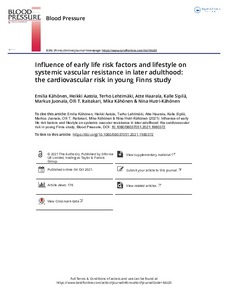Influence of early life risk factors and lifestyle on systemic vascular resistance in later adulthood: the cardiovascular risk in young Finns study
Kähönen Emilia; Aatola Heikki; Lehtimaki Terho; Haarala Atte; Sipilä Kalle; Juonala Markus; Raitakari Olli T; Kähönen Mika; Hutri-Kähönen Nina
https://urn.fi/URN:NBN:fi-fe2021110554160
Tiivistelmä
Purpose
There are limited data available concerning the effects of lifetime risk factors and lifestyle on systemic hemodynamics, especially on systemic vascular resistance. The purpose of the study was to evaluate how lifetime cardiovascular risk factors (body mass index (BMI), high-density lipoprotein, low-density lipoprotein, triglycerides, systolic blood pressure, blood glucose) and lifestyle factors (vegetable consumption, fruit consumption, smoking and physical activity) predict systemic vascular resistance index (SVRI) and cardiac index (CI) assessed in adulthood.
Materials and Methods
Our study cohort comprised 1635 subjects of the Cardiovascular Risk in Young Finns Study followed up for 27 years since baseline (1980; aged 3-18 years, females 54.3%) who had risk factor and lifestyle data available since childhood. Systemic hemodynamics were measured in 2007 (aged 30-45 years) by whole-body impedance cardiography.
Results
In the multivariable regression analysis, independent predictors of the adulthood SVRI were childhood BMI, blood glucose, vegetable consumption, smoking, and physical activity (p <= .046 for all). Vegetable consumption, smoking, and physical activity remained significant when adjusted for corresponding adult data (p <= .036 for all). For the CI, independent predictors in childhood were BMI, systolic blood pressure, vegetable consumption, and physical activity (p <= .044 for all), and the findings remained significant after adjusting for corresponding adult data (p <= .046 for all). The number of childhood and adulthood risk factors and unfavourable lifestyle factors was directly associated with the SVRI (p < .001) in adulthood. A reduction in the number of risk factors and unfavourable lifestyle factors or a favourable change in BMI status from childhood to adulthood was associated with a lower SVRI in adulthood (p < .001).
Conclusion
Childhood BMI, blood glucose, vegetable consumption, smoking and physical activity independently predict systemic vascular resistance in adulthood. A favourable change in the number of risk factors or BMI from childhood to adulthood was associated with lower vascular resistance in adulthood.
Kokoelmat
- Rinnakkaistallenteet [27094]
